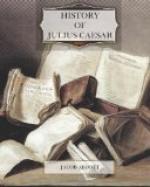CHAPTER VI.
CROSSING THE RUBICON.
[Sidenote: The Rubicon.]
There was a little stream in ancient times, in the north of Italy, which flowed westward into the Adriatic Sea, called the Rubicon. This stream has been immortalized by the transactions which we are now about to describe.
[Sidenote: Its insignificance as a stream.]
The Rubicon was a very important boundary, and yet it was in itself so small and insignificant that it is now impossible to determine which of two or three little brooks here running into the sea is entitled to its name and renown. In history the Rubicon is a grand, permanent, and conspicuous stream, gazed upon with continued interest by all mankind for nearly twenty centuries; in nature it is an uncertain rivulet, for a long time doubtful and undetermined, and finally lost.
[Sidenote: Importance of the Rubicon as a boundary.]
The Rubicon originally derived its importance from the fact that it was the boundary between all that part of the north of Italy which is formed by the valley of the Po, one of the richest and most magnificent countries of the world, and the more southern Roman territories. This country of the Po constituted what was in those days called the hither Gaul, and was a Roman province. It belonged now to Caesar’s jurisdiction, as the commander in Gaul. All south of the Rubicon was territory reserved for the immediate jurisdiction of the city. The Romans, in order to protect themselves from any danger which might threaten their own liberties from the immense armies which they raised for the conquest of foreign nations, had imposed on every side very strict limitations and restrictions in respect to the approach of these armies to the Capitol. The Rubicon was the limit on this northern side. Generals commanding in Gaul were never to pass it. To cross the Rubicon with an army on the way to Rome was rebellion and treason. Hence the Rubicon became, as it were, the visible sign and symbol of civil restriction to military power.
[Sidenote: Caesar’s expenditure of money at Rome.] [Sidenote: His influence.]
As Caesar found the time of his service in Gaul drawing toward a conclusion, he turned his thoughts more and more toward Rome, endeavoring to strengthen his interest there by every means in his power, and to circumvent and thwart the designs of Pompey. He had and partisans in Rome who acted for him and in his name. He sent immense sums of money to these men, to be employed in such ways as would most tend to secure the favor of the people. He ordered the Forum to be rebuilt with great magnificence. He arranged great celebrations, in which the people were entertained with an endless succession of games, spectacles, and public feasts. When his daughter Julia, Pompey’s wife, died, he celebrated her funeral with indescribable splendor. He distributed corn in immense quantities




